As I told you
here, Shirley's friends and work colleagues, Liz, Yvette, and Jennifer, came to visit and see Provence for the first time last fall. On this blog, I usually write about pretty villages, historical towns or monuments, and often I write about food and wine we enjoy in Provence.
Although I mention Sablet often in my posts, I have not written a lot about our wonderful village. So this time, I will share some of what we showed Liz, Yvette, and Jennifer when they came to Sablet including an alfresco lunch on the terrace at Les Abeilles Restaurant.
In case you don't know,
Sablet is a small village located near the Dentelles de Montmirail in the Vaucluse region of Provence. The village sits on a beehive shaped hill bordering the alluvial (sand, silt, clay, and gravel deposited during floods) plain of the Ouvèze River. The name Sablet comes from "sable" (sand) because the village is built on sandstone.
Sablet's neighbor to the north is Séguret, one of the "Plus Beaux Villages de France" (most beautiful villages of France) and to the south is Gigondas, a small hillside village of vintners who produce world class red wines from the surrounding vineyards.
 |
| Sablet |
Sablet is in an area between the pre-alps and the Mediterranean Sea and many people traveled through the area over the centuries. Sablet's history probably started in the 9th century when, to save the village from the invading Sarrasins, the first fortifications were built.
The village walls and towers were probably started in the 14th century and completed in 1500. They have recently been restored by the Association des Compagnons des Barrys; they are a special reminder of what life was like in Sablet during historic times.
 |
| Sablet defensive wall and tower |
Sablet's economy is dependant on tourism and the production of wine. Sablet's vignerons (winemakers) make wine from grapes grown in the vineyards surrounding the village. Sablet wines are vinified into red, rosé and white with the predominant varietal being Grenache (reds and rosés) and Grenache Blanc (white).
Sablet wines were classified Côtes du Rhône Villages Sablet in 1974. As I explained to you
here, this classification authorizes the vignerons to add "Sablet" to labels for wine produced from grapes grown in the commune and vinified in accordance with AOC rules. There are eleven independent vignerons in Sablet and 160 grape growers who sell grapes to Les Gravillas Co-op or négociants.
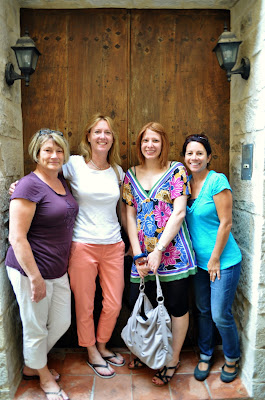 |
| Shirley and friends pause on our door step before heading out |
Just a few steps from our house is a fountain with a lavoir seen below. Except for very early in the morning or late in the evening, there are always people near the fountain; a group of older men sitting on the stone wall overlooking the street or a couple of ladies in animated conversation under the roof of the lavoir because it offers some respite from the sun.
There is a small plaque on the fountain which says "eau de source non contrôlée", which means the water is probably not safe for drinking. Despite this admonition, villagers fill buckets at the fountain and a few ladies wash clothes in the lavoir the old traditional way.
 |
| Shirley and friends at the fountain and lavoir at Place Yvan Audouard |
While Shirley gets up and around in the morning, I walk to Café des Sports for a petit café (single espresso) and conversation with Bruno. I like to watch the workers arrive, most are there every day, stopping in for a petit café or glass of red wine to fortify themselves for the work day that lies ahead.
 |
| Café des Sports |
Each arrival is greeted with a smile and a warm "bonjour," friends are greeted with "la bise" (a kiss on each cheek). The owner, Bruno Bordeaux, seems to know exactly what each person wants and their drink is ready by the time they make their way down the length of the bar saying bonjour or salut to everyone there.
 |
| Shirley and Yvette with Bruno Bordeaux |
At the end of the day, a new crowd, a mixture of locals and tourists gathers inside the café and out front on the terrace for aperitifs. On this day, we decided to have aperitifs at the café before going off to dinner. Yes, Jennifer is having a chocolat chaud (hot chocolate); Bruno was so shocked, he brought her a basket of baguette and jelly to eat with her hot chocolate.
 |
| Liz and Jennifer enjoy their aperitifs |
In 2010, Bruno bought the La Come Di Pizzeria which is conveniently, next door to Café des Sports. Pizza chef Husssein who also is a bartender at the café, churns out tasty pies you can take home or eat on the terrace accompanied by a bottle of Sablet wine from Café des Sports.
 |
| Pizza chef Hussein at La Come Di Pizzeria |
As you walk around Sablet, you will come upon picturesque streets, stairways adorned with flowers, the three churches I told you about
here, small passageways with exposed beams, and stone houses along streets so narrow, you have to slow to a crawl so your side mirrors and bumpers don't hit a house. Trust me, I have done that several times.
 |
| Grande Rue |
 |
| More of Grande Rue |
 |
| Narrow covered street |
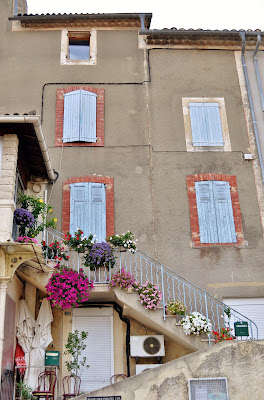 |
| Flower adorned stairway |
 |
| Covered passageway |
Sablet is a working village and we can find most everything we need; two boulangeries (bakeries) that I told you about
here and
here, a boucherie (butcher), a small grocery store, a florist, a pharmacy, a tabac/presse (where we buy magazines and daily newspapers such as La Provence and the International Herald Tribune), two hair salons, a bibliothèque (library), bank with ATM machine and post office.
Alain and Mimi Fabre own the small, but well-stocked grocery store known as "Vival Epicerie." The shelves are stocked with the usual groceries and they have a wide selection of dairy products, fruit, vegetables, cheeses, charcuterie, and beverages including pastis and local wine. While we prefer to shop at one of the weekly Provençal markets in the area, we shop often at Vival because the quality is excellent.
 |
| Alain Fabre in front of the Vival Grocery Store |
Grocery shopping in Northern California or most anywhere in the United States is so different than in Sablet. When we are in Northern California, we buy groceries at Safeway. We are lucky we have an excellent bakery close by but we don't have specialty stores where we can buy fish, meat or cheese. As I mentioned earlier, we are fortunate that Sablet has a butcher, Thierry Bonfils, who stocks a wide variety of meat, sausages and charcuterie.
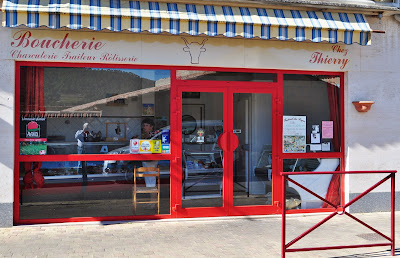 |
| Sablet Boucherie |
Our favorite poissonnier (fishmonger) is Edmond Lafont of Maree du Comtat Venaison. He always has an amazing assortment of fresh fish and seafood on display and on Thursdays, Monsieur Lafont parks his truck next to the grocery store in Sablet. There is usually a vendor selling locally made chèvre (goat cheese) at a table right in front of the fish truck.
Sablet’s Maison de Retraite (Retirement Home) is just across the road from Café des Sports.
 |
| Le Tilleul d'Or Maison de Retraite (Retirement Home) |
Some of the streets are named after artisans who lived and worked there like Rue du Cordonnier, the shoemaker's street.
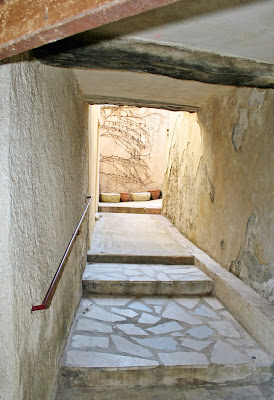 |
| Rue du Cordonnier |
In case you don't know, Sablet is famous for its book fair “Journée du Livre de Sablet” celebrated in the center of the village the 3rd weekend of every July. Well known authors and literary enthusiasts from all over come to the village for book readings and signings for this fête which spreads to many of the Sablet wineries where special events are held with music and other entertainment.
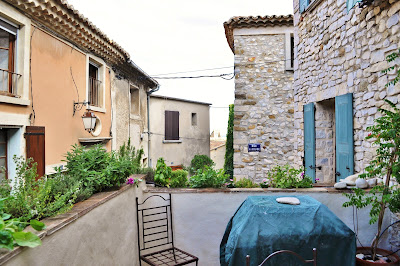 |
| View down Grande Rue from kitchen terrace |
Here are a few more views of Sablet.
 |
| View towards the Dentelles de Montmirail from bedroom balcony |
 |
| A narrow Sablet street |
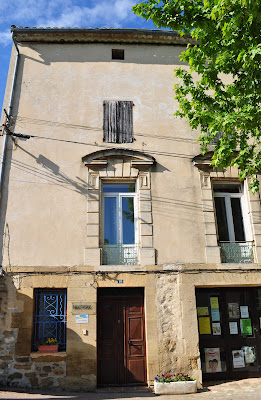 |
| Sablet Library |
Just 1.25 miles north of Sablet, and within easy walking distance, is the village of Séguret. The little village stretches around a solitary hill topped by ruins of its medieval castle. The small central square of Séguret has a 14th-century stone bell tower with a 17th-century belfry and a single-hand clock dating from 1680. On this same square is a lavoir built in 1846 and the 17th-century fountain with its four stone faces.
 |
| Shirley and friends at the fountain in Séguret |
On a perfectly sunny, warm Provencal day, we went to lunch at Les Abeilles Restaurant in Sablet with friends Liz, Yvette and Jennifer. Les Abeilles is located just a short distance from our house at the entrance to the village on the Route de Vaison.
 |
| Les Abeilles Restaurant |
Les Abeilles, literally translated "the bees", has been owned by Marlies and chef Johannes Sailer since November 2003. As soon as we were seated, Madame Sailer brought us menus and the Chef's amuse bouche to nibble while we decided what to eat.
 |
| The gang on the terrace at Les Abeilles Restaurant |
Being we were in Provence and it was a warm day, we selected a chilled bottle of 2011 Domaine Champfort Sablet Rosé from the wine list, a tasty blend of 50% Grenache and 50% Syrah.
 |
| Domaine Chamfort Sablet Rosé |
For starters, Shirley and her friends all chose simple green salads with tomatoes.
 |
| Green salad with tomatoes |
I decided to be a little more adventuresome and I chose the oysters gratinées.
 |
| Oysters Gratinées |
For main courses, the girls all chose the tagliatelles with carrots, zucchini and mushrooms in a cream sauce. Parmesan cheese was served on the side.
 |
| Pasta with a creamy vegetable sauce |
My choice was braised biche (doe) with Alsatian spaetzle.
 |
| Braised biche (doe) with Alsatian spaetzle |
One dessert choice was a tarte fine aux pommes (apple tart) with ice cream.
 |
| Tarte fine aux pommes (apple tart) |
The other dessert choice was poached pears with ice cream.
 |
| Poached pair with ice cream |
Shirley enjoyed being able to have lunch with her friends at Les Abeilles; don't you think she looks quite French with her scarf.
 |
| Shirley |
Sablet is a circular village and the streets curl up in concentric circles to the Romanesque church of St. Nazaire (12th century). The bell tower of the church is the highest point in the village. The church bell rings hourly between 7 AM and 10 PM. There is something very charming about the sounds of those bells. At night, you can see the lighted bell tower from a long ways off as you approach Sablet.
 |
| St Nazaire Church Bell Tower |
Thanks for coming along with us as we showed Liz, Yvette and Jennifer around Sablet. I can't wait till we are back in Sablet in a few weeks. Have a great day. Bonne journée mes amis et à bientôt.









